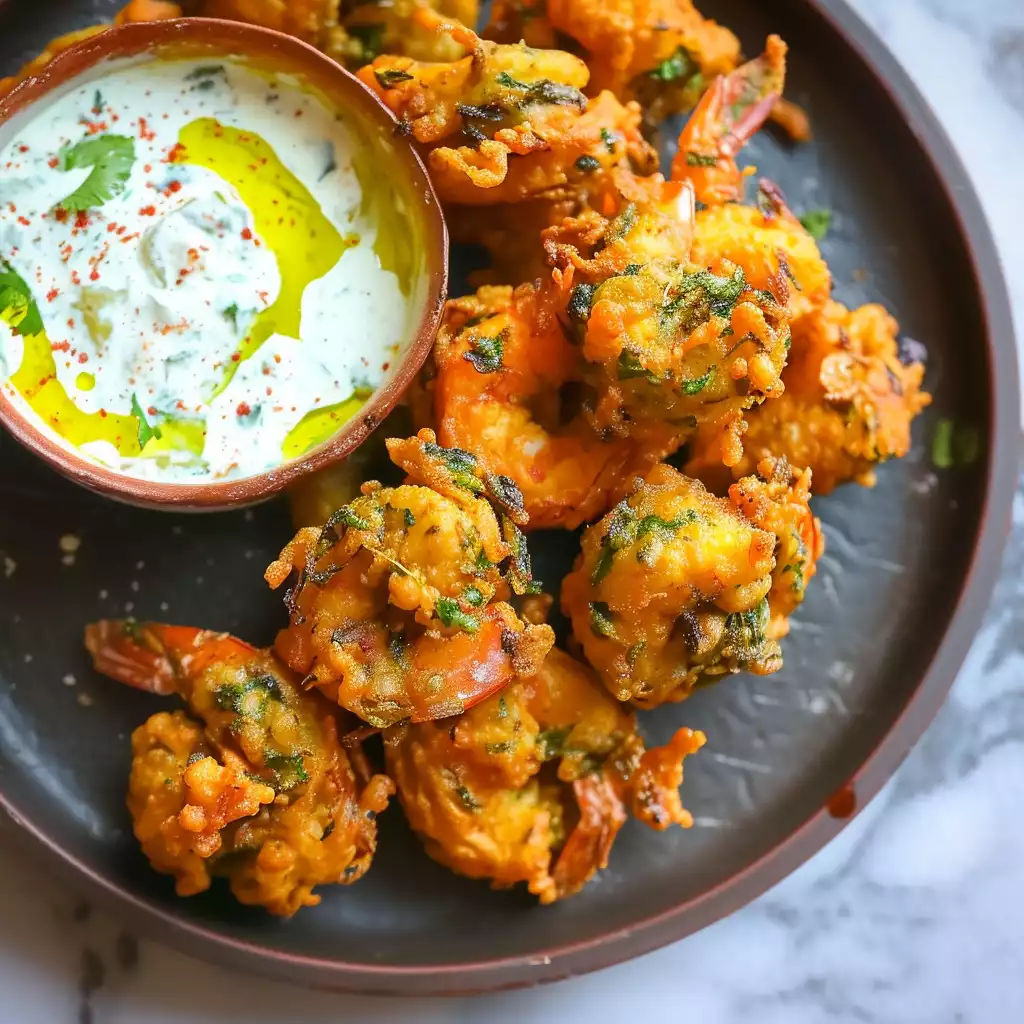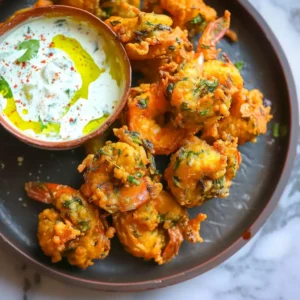
Shrimp pakora, a name that instantly brings to mind the aromatic spices and tantalizing flavours of South Asian cuisine, is a dish that has garnered much love globally.
This recipe, with its roots in the rich culinary traditions of the Indian subcontinent, is a testament to the diversity and adaptability of regional cooking styles.
The beauty of shrimp pakora lies in its simplicity and the complexity of flavours it brings to the table. The recipe we’re discussing today is not just an ordinary snack; it’s a culinary journey through the use of spices and techniques that have evolved over centuries.
This dish’s history is as rich as its flavours, having originated in the Indian subcontinent, where frying foods in spiced batter is a cooking tradition that dates back ages.
Pakoras, in general, have been a staple in Indian households, served during monsoons and at festive gatherings. Shrimp pakora, with its unique addition of seafood, adds a luxurious twist to this humble snack.
Despite its exotic appeal, shrimp pakora is surprisingly straightforward to make. This recipe falls into the easy-to-medium difficulty range, making it approachable for beginners who want to try their hand at something a bit more adventurous.
The key to perfecting this dish lies in the preparation of the batter and the frying technique, both of which are simple yet require a bit of practice to master.
Variations of shrimp pakora abound, reflecting the diverse palates and regional preferences across South Asia.
Some variations include the addition of different herbs and spices, such as ajwain or carom seeds, which add a distinct flavour, or the use of different types of flour for the batter to achieve varying textures.
In some regions, pakoras are made with a thinner batter for a lighter, crispier coating, while others prefer a thicker batter for a heartier snack.
The recipe we’re working with today uses a combination of chickpea flour and a medley of spices, including cumin, coriander, turmeric, and chili, to create a batter that is both flavourful and perfectly textured.
The shrimp are enveloped in this spiced batter and then fried to golden perfection, resulting in a snack that’s crispy on the outside and succulently tender on the inside.
Shrimp pakora is more than just a dish; it’s a celebration of flavours and textures. It represents a fusion of simple ingredients coming together to create something extraordinary.
Whether you’re hosting a get-together, looking for a delicious snack, or simply want to try something new in the kitchen, this shrimp pakora recipe is sure to impress.
As you embark on making this delightful snack, remember that the joy of cooking lies as much in the process as in the result.
Each step, from mixing the batter to frying the pakoras, is an opportunity to engage with the ingredients and techniques that make this dish so special. So, let’s dive into the world of shrimp pakora and enjoy the culinary delights it has to offer.
Expert Tip: For an extra crispy texture, ensure the oil is hot enough before frying – ideally around 180°C (350°F). A candy or deep-fry thermometer can be really handy for this.
Before we delve into the intricacies of each ingredient in our shrimp pakora recipe, let’s appreciate how each component plays its part in creating this delightful dish.
Chickpea Flour: Chickpea flour, also known as gram flour or besan, is crucial for the batter. Its nutty flavour and dense texture make it ideal for creating a crisp coating that clings to the shrimp.
If you can’t find chickpea flour, a mix of all-purpose flour and cornflour can be a good alternative, though the flavour profile will change slightly.
Baking Powder: This ingredient is a small but mighty player in our recipe. Baking powder helps in making the batter light and airy, ensuring that our pakoras are not too dense. It’s hard to find a direct substitute for baking powder in this context, as its role is quite specific.
Ground Cumin: Ground cumin adds a warm, earthy flavour that’s quintessential in many Indian dishes. It complements the shrimp beautifully. If you’re out of ground cumin, a pinch of ground caraway can be used, though the flavour will be slightly different.
Ground Coriander: This spice offers a lemony, floral note to the batter, balancing the earthiness of other spices. If unavailable, a mix of ground cumin and lemon zest can somewhat replicate its unique flavour profile.
Turmeric Powder: Turmeric gives a beautiful golden hue to the pakoras and has a subtle earthy taste. A pinch of saffron can be used as a substitute for colour, but it won’t replicate the taste of turmeric.
Chili Powder: Chili powder adds the heat. It can be adjusted to taste, or substituted with paprika for a milder version.
Salt & Black Pepper: These seasonings are fundamental. They enhance all the other flavours in the pakora.
Vegetable Oil: For frying, vegetable oil is ideal due to its high smoke point and neutral flavour. Canola or sunflower oil can be used as substitutes.
Large Shrimp: The main attraction of this dish, shrimp brings a sweet, delicate flavour and a wonderfully succulent texture. For a vegetarian version, paneer or cauliflower can be used, though the cooking time may vary.
Each ingredient in this recipe contributes to the final flavour and texture of the shrimp pakoras. Understanding their roles and potential substitutes allows for flexibility and creativity in the kitchen, ensuring that you can still enjoy this delightful dish even when some ingredients aren’t available.
Expert Tip: Experiment with the thickness of the batter. A thicker batter gives a heartier coating, while a thinner batter provides a lighter, crispier bite. Adjusting water quantity can help you find your preferred consistency.
While shrimp pakoras are best enjoyed fresh and crispy right after frying, you can prepare them ahead of time. Just keep the coated shrimp refrigerated and fry them when you’re ready to serve. Be mindful that leaving them too long can make the batter soggy.
The key to keeping pakoras crispy lies in how you fry them. Ensure the oil is hot enough before you start – ideally around 180°C (350°F). Once fried, place them on a wire rack instead of paper towels. This prevents steam from making the bottom soggy.
Shrimp pakora pairs beautifully with a variety of sauces. Mint chutney, tamarind sauce, or even a simple yogurt dip can enhance the flavours. Feel free to experiment with different sauces to find your favourite combination.
Yes, you can use frozen shrimp, but make sure to thaw them completely and pat them dry before coating them in the batter. Excess moisture can affect the texture of the pakoras.
Chickpea flour is already gluten-free, making this recipe suitable for those avoiding gluten. Just ensure that the baking powder and other ingredients are gluten-free as well.
The spiciness of shrimp pakoras can be easily adjusted. If you prefer them milder, reduce the amount of chili powder. For extra heat, add more chili powder or include finely chopped fresh green chilies in the batter.
Expert Tip: Freshness is key with shrimp. Fresh, high-quality shrimp can make a significant difference in taste and texture. If using frozen shrimp, ensure they’re completely thawed and dried to avoid excess moisture.
Here are some more recipes for you to enjoy! If you my recipes don’t forget to rate and leave a comment.
If you have any recipe suggestions, please do not hesitate to ask me. A great way to stay in contact with me is through Instagram, Facebook, Twitter and YouTube. Don’t forget to tag me @CookwithNabeela in your recipe photos!

Subscribe now to receive my latest recipes directly in your inbox. Stay up-to-date and never miss out!

I love to cook! I want to share with you my favourite, delicious family-friendly recipes. I want to inspire you to create fantastic food for your family every day.
Add your first comment to this post